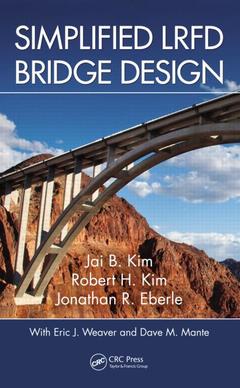Simplified LRFD Bridge Design
Coordonnateurs : Kim Jai B., Kim Robert H., Eberle Jonathan

Developed to comply with the fifth edition of the AASHTO LFRD Bridge Design Specifications [2010]??Simplified LRFD Bridge Design is "How To" use the Specifications book. Most engineering books utilize traditional deductive practices, beginning with in-depth theories and progressing to the application of theories. The inductive method in the book uses alternative approaches, literally teaching backwards. The book introduces topics by presenting specific design examples. Theories can be understood by students because they appear in the text only after specific design examples are presented, establishing the need to know theories.
The emphasis of the book is on step-by-step design procedures of highway bridges by the LRFD method, and "How to Use" the AASHTO Specifications to solve design problems.
Some of the design examples and practice problems covered include:
- Load combinations and load factors
- Strength limit states for superstructure design
- Design Live Load HL- 93
- Un-factored and Factored Design Loads
- Fatigue Limit State and fatigue life; Service Limit State
- Number of design lanes
- Multiple presence factor of live load
- Dynamic load allowance
- Distribution of Live Loads per Lane
- Wind Loads, Earthquake Loads
- Plastic moment capacity of composite steel-concrete beam
- LRFR Load Rating
Simplified LRFD Bridge Design is a study guide for engineers preparing for the PE examination as well as a classroom text for civil engineering students and a reference for practicing engineers. Eight design examples and three practice problems describe and introduce the use of articles, tables, and figures from the AASHTO LFRD Bridge Design Specifications. Whenever articles, tables, and figures in examples appear throughout the text, AASHTO LRFD specification numbers are also cited, so that users can cross-reference the material.
Introduction. LRFD Method of Bridge Design. Limit States. Load Combinations and Load Factors. Strength Limit States for Superstructure Design. Resistance Factors, Φ, for Strength Limits. Design Live Load HL-93. Fatigue Live Load. Number of Design Lanes, NL. Multiple Presence Factor of Live Load, m. Dynamic Load Allowance, IM. Live Load Distribution Factors. Load Combinations for the Strength I Limit State. Simple Beam Live Load Moments and Shears Carrying Moving Concentrated Loads per Lane. Live Load Moments and Shears for Beams (Girders). Design Examples. Design Example 1: Reinforced Concrete T-Beam Bridge. Design Example 2: Load Rating of Reinforced Concrete T-Beam by the Load and Resistance Factor Rating (LRFR) Method. Design Example 3: Composite Steel–Concrete Bridge. Design Example 4: Longitudinal Steel Girder. Design Example 5: Reinforced Concrete Slabs. Design Example 6: Prestressed Interior Concrete Girder. Design Example 7: Flexural and Transverse Reinforcement for 50 ft Reinforced Concrete Girder. Design Example 8: Determination of Load Effects Due to Wind Loads, Braking Force, Temperature Changes, and Earthquake Loads Acting on an Abutment. Practice Problems. Practice Problem 1: Non-composite 60 ft Steel Beam Bridge for Limit States Strength I, Fatigue II, and Service. Practice Problem 2: 161 ft Steel I-Beam Bridge with Concrete Slab. Practice Problem 3: Interior Prestressed Concrete I-Beam References. Primary References. Supplementary References. Appendices. Index.
Jai B. Kim, PE, PhD, is a professor emeritus of civil and environmental engineering at Bucknell University. He was department chairman for 26 years. Also, currently he is a bridge consultant (since 1980) and president of BKLB Structural Consultants, Inc. Recently he was a structural engineer at the Federal Highway Administration (FHWA). He has been active in bridge research for over 40 years, and was a member of the Transportation Research Board Committee of Bridges and Structures. He also served on the Structural PE Exam Committee of the National Council of Examiners and Surveying (NCEES) for many years. He holds a BSCE and MSCE from Oregon State University and a PhD from University of Maryland.
Robert H. Kim, PE, MSCE, is chief design engineer for BKLB Structural Consultants, Inc. He has extensive experience in the design, research, and construction of highway bridges. He has authored and presented several papers related to bridge engineering. Robert’s three books, Bridge Design for the Civil and Structural Professional Exams, Second Edition; Timber Design, Seventh Edition; and Civil Discipline Specific Review for the FE/EIT Exam are well-read by both students and engineers. In 2013, he is working on a bridge rehabilitation design in Connecticut. He holds a BS from Carnegie Mellon University and a MSCE from Penn State University.
Jonathan R. Eberle, BSCE is engaged in research with focus on the seismic design and analysis of structures at Virginia Polytechnic Institute and State University as a graduate student. He holds a BSCE from Bucknell University.
Contributors:
Dave M. Mante, MSCE performed a rigorous full-scale laboratory testing on an innovative concrete bridge deck system and he is performing research on prestressed concrete girders at Auburn University.
Eric J. Weaver, PE, M.Eng, performed research on fatigue and life-cycle analysis of steel truss bridges at Lehigh University. He worked for NASA’s space
Date de parution : 04-2013
15.6x23.4 cm
Thème de Simplified LRFD Bridge Design :
Mots-clés :
Design Lane Load; Lane Loaded; Aashto; Dynamic Load Allowance; Bridge Fatigue Load; Design Truck; Concrete Bridge Labs; Live Load; Prestressed Concrete Bridge Girder; Exterior Girders; Bridge Design; Interior Girders; Lrfd; Live Load Distribution Factors; Pe Exam; Ksi Ksi; Winds And Earthquake Loads On Bridge; Interior Beam; Concrete Bridge Girder; Design Lane; Steel Bridge Girder; Multiple Presence Factors; AASHTO Table; Exterior Beam; Noncomposite Section; Distribution Factor; Dead Load



